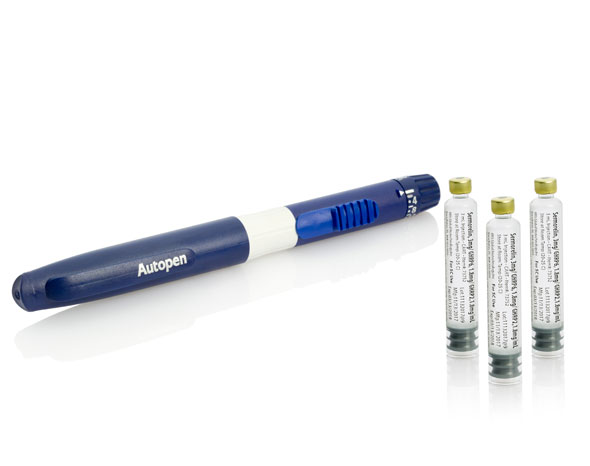- Home
- Growth Hormone
- Growth Hormone
- Growth Hormone Deficiency
- Growth Hormone Therapy
- Growth Hormone Injections
get startedThe Most Effective Hormone Replacement Therapies- General Info
- Uses for Sermorelin
- Dosage and Administration
- Benefits
- Side Effects
- Warnings
- Where to Get
- Reviews

What Is Sermorelin? Understanding Sermorelin’s Uses, Doses, and Side Effects
Sermorelin (Sermorelin-acetate) is a synthetic version of a substance naturally produced by your body known as a human growth hormone-releasing hormone, or growth hormone releasing factor (GHRH or GHRF). Sermorelin belongs to a class of biochemical compounds called secretagogues, that is; these are agents that are not necessarily active agents themselves. Instead, secretagogues can result in the release (secretion) of other agents or hormones which can then exert their effects on the body. GHRFs like sermorelin stimulate the release of growth hormone from the pituitary gland.
In children who fail to grow normally because their bodies are not producing enough growth hormone, or for adults that are also exhibiting signs and symptoms of growth hormone deficiency, sermorelin therapy can be an effective treatment.
According to the prescribing information, “Sermorelin is a sterile, non-pyrogenic, lyophilized powder intended for subcutaneous injection after reconstitution with Sodium Chloride Injection, USP.”
Sermorelin is an injectable prescription medication that can be used alone, or in combination with growth hormone injections to treat children or adults with growth hormone deficiencies. Sermorelin is only available with a doctor’s prescription.
Sermorelin is available in vials. The quantitative composition per vial is:
- 0.5 mg vial: Each vial contains 0.5 mg sermorelin (as the acetate) and 5 mg mannitol. The pH is adjusted with dibasic sodium phosphate and monobasic sodium phosphate buffer.
- 3.0 mg vial: Each vial contains 3.0 mg sermorelin (as the acetate) and 5 mg mannitol. The pH is adjusted with dibasic sodium phosphate and monobasic sodium phosphate buffer.
This medication is indicated to stimulate growth hormone secretion and facilitate growth in children or otherwise treat persons diagnosed with growth hormone deficiency or other chronic conditions that could benefit from growth hormone restoration.
Sermorelin is a growth hormone releasing factor analog. In most cases, the recommended dosage of sermorelin is 0.2 – 0.3 mcg once daily at bedtime by subcutaneous injection. According to the Prescribing Information, the exact daily sermorelin dosage can differ from patient to patient. Your exact daily dose of this medication will depend on the strength of the medicine, the number of doses you take each day, and the time allowed between doses.
The medication comes in 0.3 or 0.5mg vials. The quantitative composition per vial is:
3.0 mg vial: Each vial contains 3.0 mg Sermorelin (as the acetate) and 5 mg mannitol. The pH is adjusted with dibasic sodium phosphate and monobasic sodium phosphate buffer.
0.5 mg vial: Each vial contains 0.5 mg Sermorelin (as the acetate) and 5 mg mannitol. The pH is adjusted with dibasic sodium phosphate and monobasic sodium phosphate buffer.
Is there a Different Recommended Dosage of Sermorelin for Males and Females?
There is slight gender variation in the recommended sermorelin dosage for males and females used for the treatment of age-related growth hormone deficiency. However, the dosage is often personalized based on factors such as age, weight, and the individual’s response to treatment rather than strictly on gender. Given that the recommended doses for males and females is as follows
Sermorelin Dosage for Males
The typical starting dose for adult males is 0.2 to 0.3 mg per day (200–300 mcg/day), injected subcutaneously before bedtime. Some men may require a higher dose depending on their condition and response to therapy, but this is determined through ongoing evaluation by the healthcare provider.
Sermorelin Dosage for Females
Females often receive a slightly lower initial dose compared to males, typically 0.1 to 0.2 mg per day (100–200 mcg/day). As with males, the dose may be adjusted based on the patient’s progress and response, which can vary according to age, weight, and severity of deficiency.
Sermorelin for Dosage for Weight Loss
While sermorelin is not prescribed specifically as a weight loss drug, weight loss is definitely one of the benefits seen in those patients who are using it to treat lower-than-normal HGH levels.
The typical starting dose for both men and women is generally 0.2 to 0.3 mg per day (200–300 mcg/day), administered via subcutaneous injection. This dose can be adjusted depending on how the individual responds to treatment and their specific goals.
Sermorelin acetate for injection increases plasma growth hormone (GH) concentration by stimulating the pituitary gland to release GH. Sermorelin is similar to the native hormone (GRF [1-44]-NH 2) in its ability to stimulate HGH secretion in humans.
The benefits of increased secretion of HGH include:
- Skeletal Growth
- Increased bone density
- Cell Growth
- Organ Growth
- Increased protein metabolism
- Improved carbohydrate metabolism
- Improved Lipid Metabolism/Reduction of Body Fat
- Improve your ability to burn fat
- Promote weight loss
- Improved Mineral Metabolism – particularly resulting in an increase in bodily potassium and phosphorus levels
- Improved tissue metabolism – particularly an increase in collagen production
- Improved heart health / reduce cardiovascular risks
- Increased lean muscle and strength
- Improve your libido / erectile dysfunction and sexual performance
- Strengthen the immune system
- Increased energy and stamina
- Improved sleep
- Improve cognition and memory
- Better fracture healing
Sermorelin injections are approved by the FDA and are generally regarded as safe. However, as with any prescription medication, there are some potential side effects of sermorelin therapy.
The most common side effects of sermorelin injections are pain, swelling or redness at the injection site.
Other side effects may include:
- Headache
- Flushing
- Difficulty swallowing (dysphagia)
- Dizziness
- Hyperactivity
- Drowsiness
- Rash or hives
See your medication’s insert for a complete list of potential side-effects.
Your prescription for sermorelin will be tailored to best meet your particular goals and lifestyle. You will be carefully monitored over the course of your treatment with sermorelin, so any chance of side effects should be kept to a minimum. Tell your doctor if you are experiencing any of these or other side effects while taking sermorelin.
The only contraindication listed in the prescribing information for sermorelin use is that concomitant glucocorticoid therapy may inhibit the response to sermorelin.
There are no other particular warnings associated with sermorelin use.
There have been no reports of dependency with sermorelin, and the clinical pharmacology suggests that sermorelin is very unlikely to be associated with drug abuse
You should get your prescription for sermorelin injections from a reputable doctor or clinic that specializes in hormone replacement therapies (HRT) for men and women.
This way you can be sure that all of your levels of your critical hormones, including growth hormone and testosterone will be evaluated, and the right treatments, including sermorelin therapy will be prescribed to suit your unique needs, symptoms, goals and lifestyle
As a woman who used Sermorelin, I experienced noticeable improvements in energy, sleep quality, and overall well-being. It's been a positive addition to my health regimen
EvangeleneVerified - Growth Hormone Therapy






